Oglebay Mansion Museum
Introduction
Text-to-speech Audio
Images
This artist’s rendering of Waddington Farm is likely what the mansion looked like following Smith’s renovations.
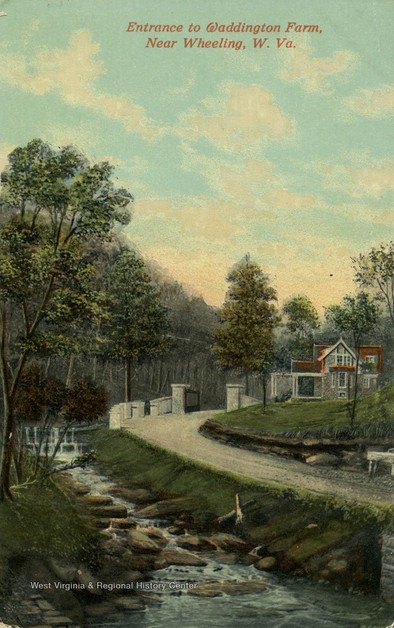
An etching of Waddington Farm from 1879.
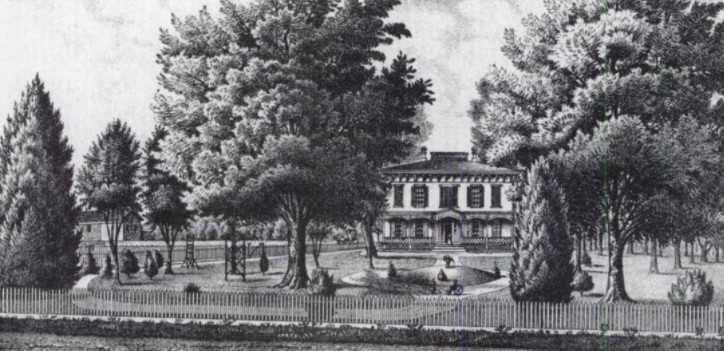
A photograph of the house in 1904, a few years after Oglebay purchased it. Some alterations had already been completed by this time, such as the wraparound porch.
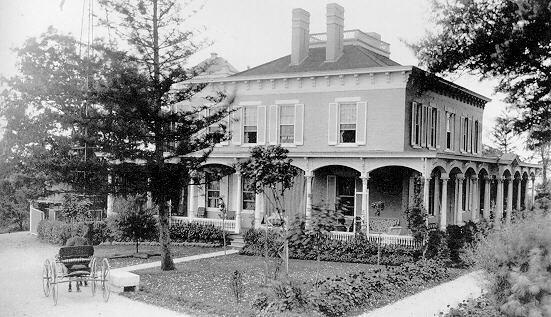
The mansion after many of Oglebay’s renovations, 1910.
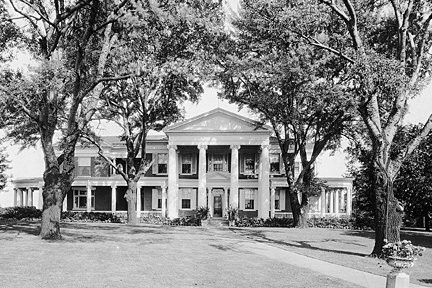
Oglebay in front of the building.
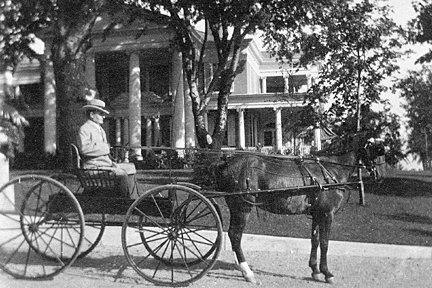
Women on the porch of the mansion learning how to weave baskets, 1927.
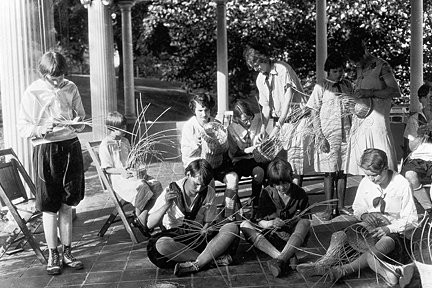
Postcard of the early days of the Mansion Museum.
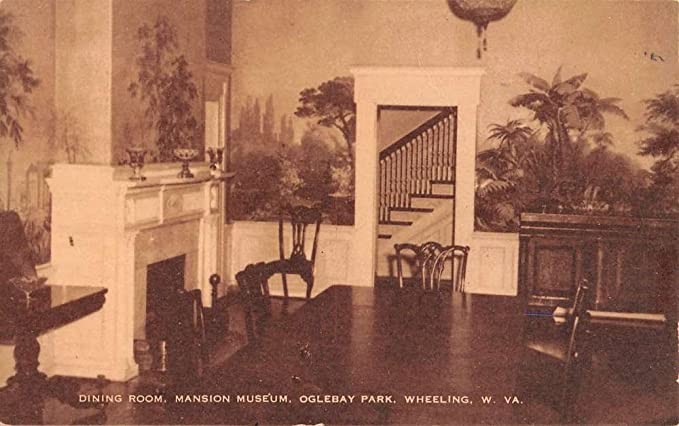
The Mansion Museum today.
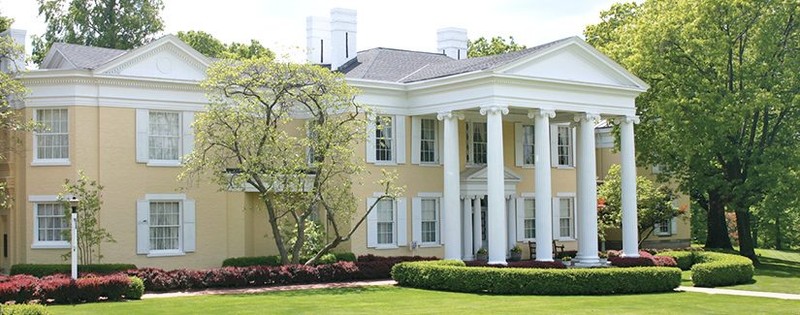
An example of the splendidly furnished interior of the museum.
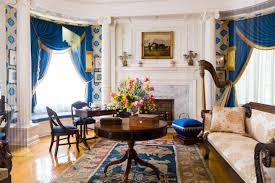
Backstory and Context
Text-to-speech Audio
Following landowner Samuel Sprigg’s death in 1843, his daughter Elizabeth Sprigg inherited 415 acres of land. Shortly after receiving her inheritance, the Sprigg daughter became betrothed to Hanson W. Chapline, a Wheeling doctor. The young couple were soon married and began construction on a house on their new farm, which Chapline called “Hill Farm.” Construction likely began around 1844. When Chapline officially took ownership of the property in 1846, Elizabeth and Hanson were listed as already living on the farm, suggesting that the house was finished by mid-1846.
The original building constructed by Sprigg and Chapline was a brick Greek Revival structure. A cut stone foundation supported the two-story building, which was rectangular, sturdy, and mostly symmetrical. Detailing was kept to a minimum, though the five bay facade indicates that calling the house modest is a little misleading. Windows were six over six sash arrangements with thin mullions. Iron grates were set in front of the basement windows. A median pitch hipped roof capped the structure. The front door was recessed slightly and originally contained a transom and sidelights. The interior maintains the symmetricality of the exterior. A central hallway divides the house in half with each floor possessing four equally sized rooms. There are chimneys on both the left and right sides of the house, and each chimney is shared by the front and back rooms. While the main floor has brick walls, the second floor has mostly wooden clapboard. Pine wood was used throughout the home. A small excavated basement extended only under the back left room and part of the hall. The only part of the original plan that interrupts the symmetry is a small hall off the back left room, which led to a carriage entrance.
The Chaplines occupied their new home for just a little over a decade. In 1856, wealthy brewer George W. Smith purchased the property for $30,000 — a little over $900,000 adjusted for inflation. Smith changed the name of the farm to “Waddington Farm,” after his family’s home in Waddington Heath, United Kingdom. Smith also significantly enlarged the house. Renovations began as soon as the brewer purchased the building and continued throughout the 1850s and 60s. An entire wing was added to the back right of the home. This wing included a full basement, kitchen, pantry, and two more second-floor bedrooms. Windows and brickwork were matched to the main building, though the basement of the addition utilized full windows due to the slope of the land exposing the walls. Smith also altered the interior of the house. Many pieces of the pine woodwork, such as the fireplace mantels, were replaced with marble accents. It is also likely that the front porch was added under Smith’s tenure, as an etching from 1879 shows the home with one.
Smith sold Waddington Farm in 1872, after which the estate passed through many hands. However, no further major alterations were made until Earl W. Oglebay acquired the property in 1900. Oglebay undertook a complete overhaul of the house. He hired Wheeling architects Franzheim and Kleives to transform the building from a Greek Revival style to a Neoclassical Revival style. The back rooms were expanded, the porch was made to wrap fully around three sides of the house, and the doorway was completely replaced. In 1905, an addition was made to the back left of the house. The first floor of this space contained an oval room, while the second floor had a master bedroom and bathroom. Many interior features were restored, though Oglebay avoided replacing them whenever possible. After steadily creeping in this direction for many years, the house at Waddington Farm was undeniably a mansion under Oglebay’s ownership.
After Oglebay willed Waddington Farm to the city of Wheeling in 1926, the house on the property became the Mansion Museum in 1930. The Mansion Museum was even the first facility in West Virginia to be accredited by the American Association of Museums. This cultural site continues to operate today, offering tours of the house and providing information about its previous owners. In 1962, a major renovation was undertaken to modernize the Mansion Museum, while maintaining the historical integrity of the building. New wiring was added, a furnace was installed, and the roof was replaced as part of this project. Bathrooms and fire-code necessities were also added. Despite these changes, all three of the building’s major phases are still readily visible and it remains the oldest extant structure in Oglebay Park. The Mansion Museum was added to the National Register of Historic Places in 1979.
Sources
About Oglebay Institute, Oglebay Institute. Accessed February 22nd 2021. https://oionline.com/about/.
Artzberger, John A. Waddington Farm Mansion, National Register of Historic Places. June 21st 1979. Accessed February 22nd 2021. http://www.wvculture.org/shpo/nr/pdf/ohio/79002595.pdf.
Carney, Brent. Oglebay Park. Mount Pleasant, SC. Arcadia Publishing, 2005.
Experience Oglebay, Oglebay. Accessed February 22nd 2021. https://oglebay.com/experience-oglebay/.
Fisanick, Christina. Oglebay - The Park That Almost Wasn't, Weelunk. July 25th 2018. Accessed February 22nd 2021. https://weelunk.com/oglebay-the-park-that-almost-wasnt/.
The History of Oglebay, Oglebay. Accessed February 22nd 2021. https://files.meetup.com/513500/History%20of%20Oglebay%20Park.pdf.
Myer, Christina. Oglebay Park, The West Virginia Encyclopedia. December 3rd 2018. Accessed February 22nd 2021. https://www.wvencyclopedia.org/articles/1733.
Steenrod, Blanche. Potpourri Article: Oglebay Park, Ohio County Public Library. April 10th 1938. Accessed February 22nd 2021. https://www.ohiocountylibrary.org/research/wheeling-history/4030.
“Entrance to Waddington Farm, Near Wheeling, W. Va.” West Virginia & Regional History Center. Accessed February 22, 2021. https://wvhistoryonview.org/catalog/041485.
Oglebay Park. Accessed February 26, 2021. https://books.google.com/books?id=Fho584EEKzYC&pg=PA16&lpg=PA16&dq=crispin+oglebay&source=bl&ots=ciOgPzjjIa&sig=ACfU3U0tuK_tiRonU3pmVOQawxU4hxFZZw&hl=en&sa=X&ved=2ahUKEwikpayQkIjvAhWJjlkKHX9MCok4FBDoATABegQIAxAD#v=onepage&q&f=true.
1904. Wikimedia. Accessed February 23, 2021. https://en.wikipedia.org/wiki/File:Earlyoglebay1.jpg.
1910. Facebook. Accessed February 23, 2021. https://www.facebook.com/Oglebay/photos/a.456791830223.381941.44302399522/456803210223.
Facebook. Accessed February 23, 2021. https://www.facebook.com/Oglebay/photos/a.456791830223.381941.44302399522/456803170223.
Facebook. Accessed February 23, 2021. https://www.facebook.com/Oglebay/photos/a.456791830223.381941.44302399522/456941305223.
Amazon. Accessed February 23, 2021. https://www.amazon.com/Wheeling-Virginia-Mansion-Oglebay-Postcard/dp/B01M8I389R.
Oglebay Institute. Accessed February 23, 2021. https://oionline.com/museums/.
Oglebay. Accessed February 23, 2021. https://oglebay.com/activities/museums/mansion-museum/.
